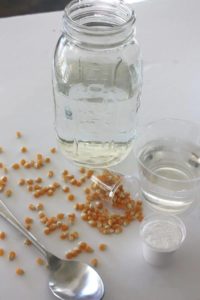Dancing Corn Thanksgiving S.T.E.M. Activity
 With Thanksgiving just around the corner, kids will have a break from school. What can you do to keep your child engaged while you prepare for your Thanksgiving feast? We have a fun Magical Dancing Corn Experiment for you to try at home. Fall is the perfect time to experiment with pumpkins, apples, and even corn! Our dancing corn experiment is a great example of a chemical reaction, and kids love these amazing reactions just as much as adults! This bubbling corn experiment appears almost magical, but it really just uses baking soda and vinegar for a classic chemical reaction.
With Thanksgiving just around the corner, kids will have a break from school. What can you do to keep your child engaged while you prepare for your Thanksgiving feast? We have a fun Magical Dancing Corn Experiment for you to try at home. Fall is the perfect time to experiment with pumpkins, apples, and even corn! Our dancing corn experiment is a great example of a chemical reaction, and kids love these amazing reactions just as much as adults! This bubbling corn experiment appears almost magical, but it really just uses baking soda and vinegar for a classic chemical reaction.
As a warning, this dancing corn experiment can get a bit messy in a fun way, so make sure to have a surface or area you can easily clean up. You can even start by placing your glass or jar in a pie dish or on a cookie sheet to catch the overflow.
What You Will Need:
- Tall Jar or Glass (Mason jars work well-needs to be glass so you can see)
- 1/8-1/4 cup of popping corn
- 2 T of baking soda
- 1 cup of vinegar (or use as much as needed)
- Food Coloring (optional)
- 2 cups of water
STEP 1. Grab your ingredients and let’s get experimenting! You can use just about any tall glass or jar. An adult might want to assist with the measuring and pouring if necessary, but it’s also great practice for junior scientists to practice math and grading movement.
STEP 2. Have the kiddo(s) fill the jar with 2 cups of water to start. Have the kiddo(s) find the correct measurement on the measuring cup and have them fill and pour.
STEP 3. Add 2 tablespoons of baking soda and stir well to mix thoroughly. Here you can talk about which solids dissolve in water! As above, have the child(ren) find the correct measuring spoon as well.
STEP 4. Add a drop of food coloring (optional).
STEP 5. Now add the popping corn kernels or popcorn. You don’t need to add too many for a fun dancing effect.
STEP 6: Here you can make predictions about what will happen! (How will the corn dance? What is making the corn dance? When will the corn stop dancing?)
STEP 7. Now here comes the fun part! You can slowly add the vinegar and watch what happens. Or you can add the vinegar quickly and observe!
The Science of Dancing Corn
Chemistry is all about states of matter including liquids, solids, and gasses. A chemical reaction occurs between two or more substances that change and form a new substance. In this case, you have an acid (liquid: vinegar) and a base (solid: baking soda). When combined, they make a gas called carbon dioxide which produces the eruption you can see, as well as the dancing action.
The secret to the magic dancing corn is the baking soda and vinegar chemical reaction. The carbon dioxide bubbles lift the corn, but as the bubbles pop, the corn falls back down! You can repeat this experiment over and over again.
Stir the mixture if you like or you can just observe it as is! You can time the dancing corn to see how long the carbon dioxide bubbles will last and make the corn dance.
You can even add more baking soda to the jar and continue to watch the corn dance. Through this activity of the dancing corn, the children will think this is magical all the while teaching them about science and growing their love and interest. For more fun Thanksgiving S.T.E.M. experiments, check out Little Bins Little Hands. You can also check out our Science Experiment page for other fun ideas.
